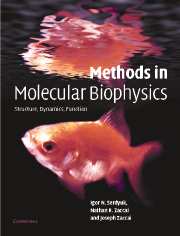Book contents
- Frontmatter
- Contents
- Foreword by D. M. Engelman
- Foreword by Pierre Joliot
- Preface
- Introduction: Molecular biophysics at the beginning of the twenty-first century: from ensemble measurements to single-molecule detection
- Part A Biological macromolecules and physical tools
- Part B Mass spectrometry
- Part C Thermodynamics
- Part D Hydrodynamics
- Part E Optical spectroscopy
- Part F Optical microscopy
- Part G X-ray and neutron diffraction
- Part H Electron diffraction
- Chapter H1 Electron microscopy
- Chapter H2 Three-dimensional reconstruction from two-dimensional images
- Part I Molecular dynamics
- Part J Nuclear magnetic resonance
- References
- Index of eminent scientists
- Subject Index
- References
Chapter H2 - Three-dimensional reconstruction from two-dimensional images
from Part H - Electron diffraction
Published online by Cambridge University Press: 05 November 2012
- Frontmatter
- Contents
- Foreword by D. M. Engelman
- Foreword by Pierre Joliot
- Preface
- Introduction: Molecular biophysics at the beginning of the twenty-first century: from ensemble measurements to single-molecule detection
- Part A Biological macromolecules and physical tools
- Part B Mass spectrometry
- Part C Thermodynamics
- Part D Hydrodynamics
- Part E Optical spectroscopy
- Part F Optical microscopy
- Part G X-ray and neutron diffraction
- Part H Electron diffraction
- Chapter H1 Electron microscopy
- Chapter H2 Three-dimensional reconstruction from two-dimensional images
- Part I Molecular dynamics
- Part J Nuclear magnetic resonance
- References
- Index of eminent scientists
- Subject Index
- References
Summary
EM in biology
Structural biology with EM
Electron microscopes can provide vivid details of biological macromolecules at the nanometre scale.
Recall from Chapter H1, an electron image is a two-dimensional projection of the object along the electron beam. A three-dimensional reconstruction of the object can be obtained by combining data measured at different angular projections. In single-particle reconstruction, a population of molecules is imaged. If these are identical (monodisperse) and present in sufficient quantities, the data from differently oriented molecules can be combined to produce an accurate three-dimensional reconstruction of the structure. The presence of symmetry is taken advantage of in helical reconstruction and two-dimensional crystallography. In tomography, the same object is imaged at different orientations. The different images are then combined together to recreate its structure.
Examples of electron cryo-microscopy reconstructions
In EM, the image is the result of the interaction of the incident electrons with the electrostatic distribution due to the atomic structure of the sample. The reconstruction of the structure results from the analysis of many images. Three-dimensional reconstructions at different resolutions depict the object at different levels of detail (Figure H2.1).
At atomic resolution, it is a good approximation to understand this structural density as being equivalent to the electron density obtained by X-ray diffraction, but with a larger contribution from hydrogen atoms in the electron diffraction case. It should furthermore be possible to distinguish the charge state of amino acids.
- Type
- Chapter
- Information
- Methods in Molecular BiophysicsStructure, Dynamics, Function, pp. 904 - 928Publisher: Cambridge University PressPrint publication year: 2007



